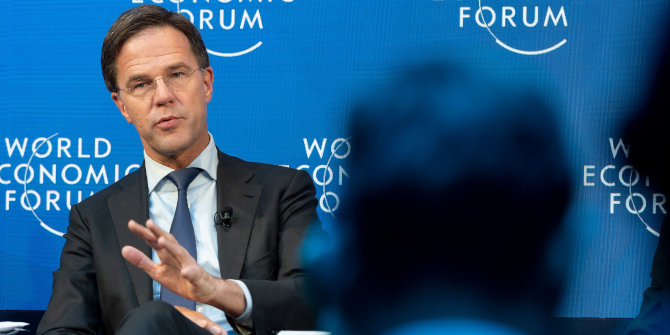Although radical right populist parties in Europe are still predominantly led by and supported by men, there has been a marked increase in the number of women with high profile roles in these parties. Drawing on a new study, Ana Catalano Weeks, Bonnie M. Meguid, Miki Caul Kittilson and Hilde Coffé ask whether we should view this trend as a genuine step toward better representation for women.
The idea of women in far right politics is far from a novelty. Marine Le Pen has been at the helm of France’s leading radical right populist party for over a decade and is now in the final stages of her third attempt to win the French presidency. She is no longer the exception to the rule.
While radical right populist parties are still mostly led by, represented by, and supported by men, there has been a marked increase in the number of women leaders and women MPs in these parties. It is hard to reconcile the very conservative views that these parties have traditionally held on women’s role in society with this uptick in women’s representation. In a recent study, we sought to examine this phenomenon.
Women’s descriptive representation as a powerful electoral tool
A common assumption in political science is that political parties are rational actors, seeking to maximise their electoral support. Like any major shift, therefore, it is fair to question whether the advancement of traditionally underrepresented groups such as women arises from a strategic calculation to win more support, influence, and seats.
By this logic, increasing women’s descriptive representation is especially appealing to those radical right populist parties that need more women voters. An increase in women’s descriptive representation can thus be seen as a tactic for broadening a party’s electorate in order to attract previously untapped women voters and remedy the party’s stagnation or decline.
Strategic descriptive representation
Our theory, which we label as strategic descriptive representation, may be particularly relevant for radical right populist parties given that they have a large overrepresentation of men among their electorate. Our findings are based on a unique dataset on women as MPs, party leaders and gender differences in voter support in Europe – the most comprehensive to date, including 187 parties in 30 Western and Eastern European countries from 1985 to 2018. We find that radical right populist parties embrace women as MPs when they are electorally struggling and women are underrepresented among their voters – an electoral, rather than ideological, decision.
The efficacy of strategic descriptive representation is not limited to radical right populist parties. In theory, any party that needs to broaden its electoral support, while simultaneously lacking women’s votes, could look to promote more women. An extension of our analyses to all European parties reveals that Christian Democratic parties similarly see gender as a tool for bolstering their electoral fortunes, in their case, using men MPs to counter their women-dominated electorate. For other party families, key conditions for strategic descriptive representation by gender appear to be absent. For instance, Green and Social Democratic parties have relatively high proportions of women voters and MPs already. Their use of strategic descriptive representation tactics might target other demographic groups that they struggle to attract.
‘SVP Girls’ and ‘Geert’s Angels’
Two illustrations of radical right populist parties relying on the tactic of strategic descriptive representation are the SVP in Switzerland in 2015 and the Party of Freedom (PVV) in the Netherlands in 2017. In both cases, the conditions for strategic descriptive representation were present: the party had a gender gap in voting and faced recent electoral challenges.
Both parties highlighted the presence of women in their campaigns prominently. The SVP “decorated its campaign with women”. The message behind “Swiss Girls Vote JSVP” (the youth wing of the SVP) was simple: (young) women should vote for the SVP because its candidates were not “old, wrinkled men,” but rather looked like them.
Figure 1: ‘Swiss Girls Vote JSVP’
Translation: “In the SVP there are only old, wrinkled men”
Like its national campaign, regional SVP campaigns also revealed deliberate strategies to attract women voters. In the canton of Solothurn, for example, the SVP nominated an all-women’s list and founded a women’s section one month before the election. Local party president Silvio Jeker claimed that the SVP had “a good basis to now gain a foothold with women,” while then local party vice president Christine Rütti said, “we need more middle-class women.” As a result of this concerted gender-based strategy, the women’s share of elected SVP MPs rose by six percentage points, reaching 17% of the delegation. With this election, the SVP also closed their gender gap in voter support, bolstering the party’s vote gains.
Figure 2: ‘Geert’s Angels’
Note: Cover of De Telegraaf, January 6, 2017
The Dutch PVV have also targeted women voters with women’s faces. In line with our theory, in 2017, the PVV presented a party list top-heavy with women MP candidates: the prized second and third spots on the list were both occupied by women. Wilders announced the party list with a photo shoot of the top three candidates: himself flanked by the two women, Fleur Agema and Vicky Maijer. The news made the front page of the largest Dutch daily, De Telegraaf, with the headline, “Geert’s Angels”.
Progress or dangerous window dressing?
Bolstering women’s descriptive representation is a relatively low-cost tool for radical right populist parties to broaden their electorate and increase their vote share. Rather than enacting costly shifts of their policy platforms or adding a new issue which requires messaging and explanation, radical right populist parties are often running more women for election.
One question that looms large is what this strategic use of representation means for the long-term quality of representation and equality in democratic societies. While the newly elected women may potentially bring their own policy ideas and priorities, eventually diversifying the party platform, the strategic use of women’s descriptive representation may forego important structural changes within the party in favour of visible symbols, potentially undermining democratic representation and the substantive effect that women MPs can have.
In addition, if women’s strategic descriptive representation helps to normalise the radical right populist party’s image and increases the vote shares of such xenophobic parties, it raises serious questions about whether descriptive representation is still a normative good in this context. Do the new elected women promote gender equality for all, or do they strategically deploy gender equality tactics to bolster their nationalist and, often misogynistic, agendas? Will this increased political representation lead to progress on women’s substantive representation, or is it ultimately just window dressing?
For more information, see the authors’ accompanying paper in the American Political Science Review
Note: This article gives the views of the authors, not the position of EUROPP – European Politics and Policy or the London School of Economics. Featured image credit: Vox España (Public Domain)






